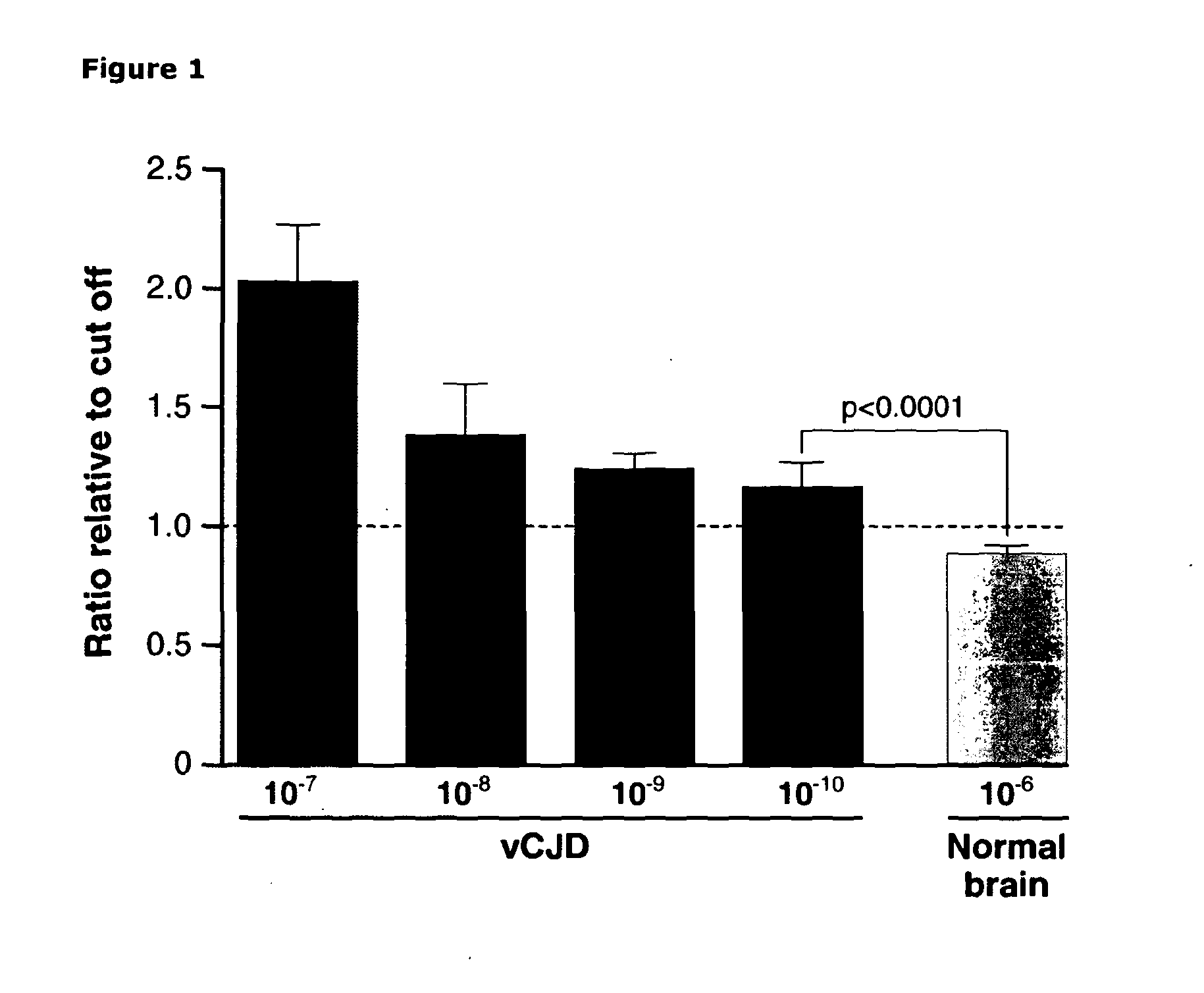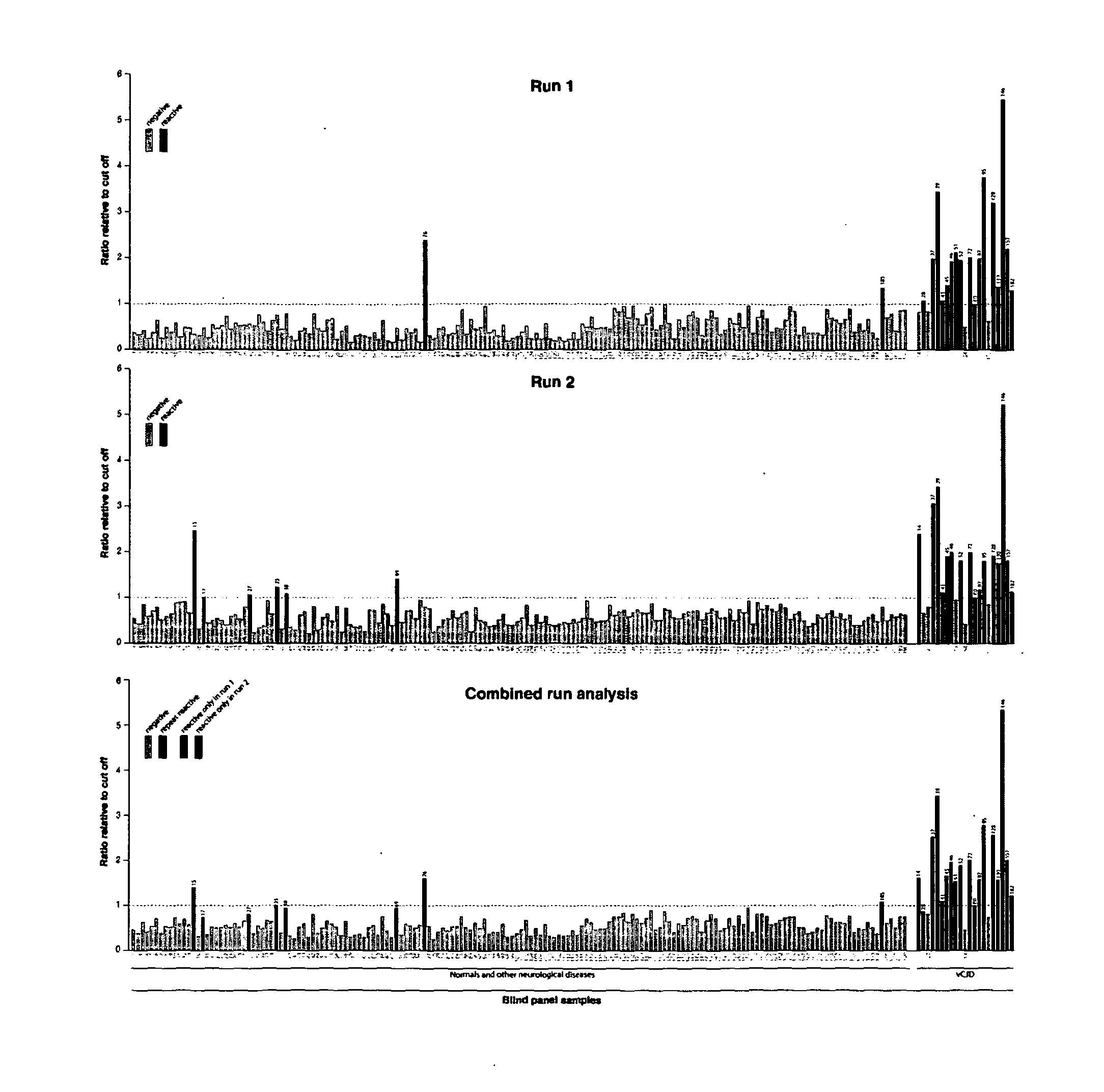Assay for Prions
a technology for prions and assays, applied in the field of assays for prions, can solve the problems of inability to accurately risk-assess the risk of future transfusion of vcjd, the current risk reduction strategy in the uk is extremely expensive, and significant problems for us public and military blood transfusion services, so as to avoid protease treatment, avoid immunoprecipitation steps, and excellent results
- Summary
- Abstract
- Description
- Claims
- Application Information
AI Technical Summary
Benefits of technology
Problems solved by technology
Method used
Image
Examples
example 1
Detection of vCJD Brain Homogenate Spiked into Whole Blood
[0292]In order to determine the sensitivity of the assay relative to other methods we analysed serial dilutions of vCJD brain homogenate diluted into whole blood to provide a background diluent as close to endogenous patient samples as possible. A dilution range of 10−7 to 10−10 of 10% w / v vCJD brain homogenate was assayed and compared to a high background concentration (10−6) of normal brain homogenate (10% w / v) also diluted in whole blood. Although a non-linear response was seen with respect to dilution, vCJD-infected brain homogenate could clearly be distinguished from control even at a 1010 fold dilution (FIG. 1), a sensitivity more than 4 logs higher than previously achieved for immunoassay of vCJD tissue (31). A chemiluminescent signal of 1.3×105+ / −1.1×104 (mean+ / −SD) was obtained with 10−10 dilution of vCJD-infected brain versus 9.9×104+ / −4.5×103 for a 10−6 dilution of normal control brain. Data is expressed as a ratio...
example 2
Identification of vCJD Infected Patient Bloods
[0293]Initial studies performed using exogenous spikes of vCJD-infected brain homogenate in whole human blood demonstrated our assay was capable of discriminating between infected and non-infected samples with a sensitivity theoretically sufficient to detect infection in vCJD blood based upon estimates of titre obtained from rodent models (22;23). However, the biochemical nature of infectivity and abnormal PrP associated with blood is unknown and the results obtained from exogenous spiking experiments cannot be assumed to apply to authentic patient samples. To ensure this level of discrimination could be achieved with endogenous blood samples we tested a sub-set of confirmed vCJD patient bloods obtained from the National Prion Clinic and compared these to normal control bloods obtained from the NBS (FIG. 2). The samples were analysed as groups which had mean chemiluminescent signals that were significantly different (p value<0.0001, unpa...
example 3
Blind Panel Analysis
[0294]In order to confirm our results and remove any bias from the analysis a panel of 190 samples taken from 21 confirmed vCJD patients (National Prion Clinic), 69 patients with other neurological disease and 100 normal healthy controls (NBS) were blinded by parties independent to the testing and analysis. The samples were tested in batches of 19 samples with internal controls to determine a cut-off threshold for each plate, samples which gave chemiluminescence signals above the cut-off were deemed reactive. To eliminate potential false positive reactions originating not from the sample but from contamination or assay errors each sample was tested twice within independent assay runs (FIG. 3). Only those samples which were repeat reactive in both assays were scored as positive.
[0295]From the panel of 190 samples tested a total of 19 and 22 were reactive in assays 1 and 2 respectively (FIG. 3). A subset of 15 of those samples gave signals above the cut-off thresho...
PUM
| Property | Measurement | Unit |
|---|---|---|
| volume | aaaaa | aaaaa |
| volume | aaaaa | aaaaa |
| concentration | aaaaa | aaaaa |
Abstract
Description
Claims
Application Information
 Login to View More
Login to View More - R&D
- Intellectual Property
- Life Sciences
- Materials
- Tech Scout
- Unparalleled Data Quality
- Higher Quality Content
- 60% Fewer Hallucinations
Browse by: Latest US Patents, China's latest patents, Technical Efficacy Thesaurus, Application Domain, Technology Topic, Popular Technical Reports.
© 2025 PatSnap. All rights reserved.Legal|Privacy policy|Modern Slavery Act Transparency Statement|Sitemap|About US| Contact US: help@patsnap.com



